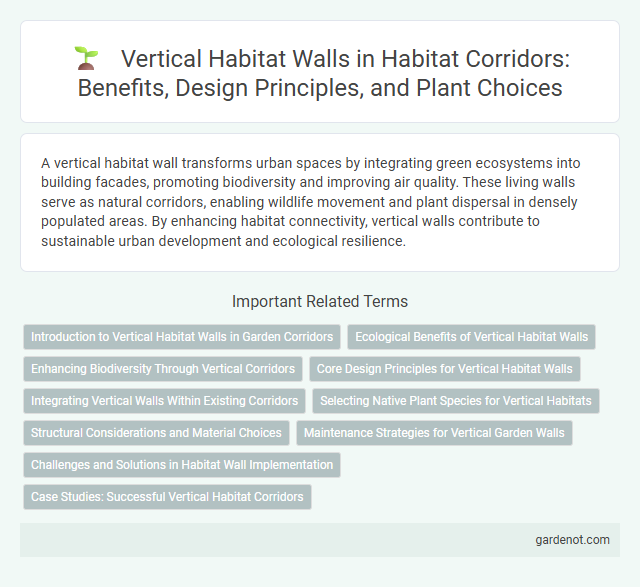A vertical habitat wall transforms urban spaces by integrating green ecosystems into building facades, promoting biodiversity and improving air quality. These living walls serve as natural corridors, enabling wildlife movement and plant dispersal in densely populated areas. By enhancing habitat connectivity, vertical walls contribute to sustainable urban development and ecological resilience.
Introduction to Vertical Habitat Walls in Garden Corridors
Vertical habitat walls in garden corridors create layered ecosystems by integrating native plant species that support pollinators, birds, and beneficial insects. These living structures enhance biodiversity while maximizing limited space through vertical growth, improving air quality and providing natural insulation. Incorporating vertical habitat walls promotes ecological connectivity between fragmented habitats, fostering resilient urban green corridors.
Ecological Benefits of Vertical Habitat Walls
Vertical habitat walls enhance urban biodiversity by providing critical nesting sites and food sources for pollinators, birds, and small mammals. These structures improve air quality through increased photosynthesis and contribute to urban heat island mitigation by cooling surrounding environments. By connecting fragmented green spaces, vertical habitat walls promote species movement and genetic diversity within ecological corridors.
Enhancing Biodiversity Through Vertical Corridors
Vertical habitat walls create essential corridors that support biodiversity by connecting fragmented ecosystems within urban environments. These living structures host diverse plant species, which attract pollinators, birds, and insects, facilitating species movement and genetic exchange. By integrating vertical corridors, cities can restore ecological balance and promote resilient urban biodiversity.
Core Design Principles for Vertical Habitat Walls
Core design principles for vertical habitat walls emphasize biodiversity support, structural stability, and ecological connectivity. Incorporating native plant species enhances local fauna attraction, while modular and lightweight materials ensure ease of installation and maintenance. Strategic placement maximizes sunlight exposure and water efficiency, promoting sustainable urban ecosystems within compact spaces.
Integrating Vertical Walls Within Existing Corridors
Integrating vertical habitat walls within existing corridors enhances biodiversity by providing additional niches for flora and fauna while optimizing limited urban and suburban spaces. These vertical structures facilitate species movement and create microhabitats that support pollinators, birds, and small mammals, complementing traditional horizontal green corridors. Implementing vertical habitat walls harnesses structural surfaces to expand ecological connectivity and improve habitat quality in fragmented landscapes.
Selecting Native Plant Species for Vertical Habitats
Selecting native plant species for vertical habitat walls enhances biodiversity by supporting local wildlife and improving ecological resilience. Native plants require less maintenance and water, adapting naturally to local climate and soil conditions, which ensures long-term sustainability of vertical habitats. Incorporating a diverse range of native species promotes microhabitats, aiding pollinators and contributing to urban ecosystem health.
Structural Considerations and Material Choices
Vertical habitat walls require robust structural support to ensure stability and load-bearing capacity, especially when accommodating plant growth and wildlife movement. Selecting durable, weather-resistant materials such as treated steel, reinforced concrete, or composite panels enhances longevity while minimizing maintenance needs. Integrating lightweight substrates alongside moisture-retentive layers optimizes plant health and structural integrity within urban corridor environments.
Maintenance Strategies for Vertical Garden Walls
Maintenance strategies for vertical habitat walls emphasize regular irrigation monitoring, ensuring consistent moisture levels to support plant health and biodiversity. Incorporating automated irrigation systems with sensors aids in optimizing water usage while preventing overwatering and root rot. Periodic pruning and nutrient supplementation maintain structural integrity and promote vigorous growth within vertical garden ecosystems.
Challenges and Solutions in Habitat Wall Implementation
Implementing vertical habitat walls faces challenges such as structural load capacity, plant selection compatibility, and irrigation system efficiency to ensure sustainable growth and biodiversity. Solutions involve advanced lightweight materials, tailored species suited for vertical environments, and integrated sensor-based automated watering systems to optimize water use and maintain plant health. Addressing these factors enhances habitat wall longevity and ecological functionality in urban spaces.
Case Studies: Successful Vertical Habitat Corridors
Vertical habitat walls have proven effective in urban biodiversity restoration, as demonstrated by the Singapore Changi Airport Green Wall, which supports over 100 native plant species and attracts diverse pollinators. In Milan, Italy, the Bosco Verticale towers integrate vertical corridors that enhance bird migration paths and improve air quality by hosting 900 trees and 5,000 shrubs. These case studies illustrate how vertical habitat corridors can transform dense urban environments into thriving ecosystems that support wildlife connectivity and ecological resilience.
Vertical habitat wall Infographic

 gardenot.com
gardenot.com